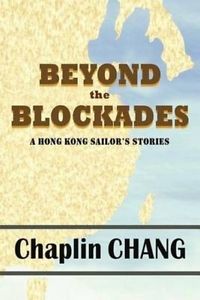People of the generation which lived through the second world war often have fantastic stories to tell, whether in Europe or Asia, and whether they were combatants or not.
Growing up in England, I could listen to my relatives' stories of the 1940s firsthand; my 97-year-old great-aunt, for example, can speak about the war experiences of her parachutist husband as if they happened yesterday. In Hong Kong, it is more difficult for me to hear these stories. Understandably, most local writers record their memories in Chinese.
And so I was interested when a friend handed me a copy of Beyond the Blockades, a collection of stories about smuggling goods into mainland ports during China's civil war, which has been self-published by the author Chaplin Chang.
Chang's story starts in Gulangyu, an island off Amoy (today's Xiamen), where he went to school at the Anglo-Chinese College. As an international settlement, Gulangyu was left alone when Japanese forces occupied Amoy in 1938. Chang and his brothers were able to see planes bombing the city, and the famous Amoy canning company used their huge factory woks to cook congee and beans for the injured soldiers who came pouring over to the island. Chang combined his studies with taking food to the refugees until one morning – in December, 1941 – he left his home to find his way blocked by a Japanese soldier, who chased him back indoors at bayonet point. Japan had crossed the strait and occupied Gulangyu overnight.
Chang's education ended there and then, in his third year at junior school. Life was difficult under the Japanese so the family were soon smuggled to the mainland by Chinese agents.
One thing led to another, and despite having no real interest in a military career, Chang ended up joining the ROC Navy thanks to an acquaintance who let him copy his answers at the entrance exam. He was sent to England for training, and then returned on one of two ships which were leased to the ROC by Britain's Royal Navy. But things didn't go to plan. On the Yangtze, the other ship suffered a mutiny and sailed north to join the Communists. Chang's ship was ordered south to Hong Kong, where he found himself out of a job and unable to speak the local language.
Chang didn't like the Communists. But with a mother and brother to support, he had to take any job offered to him, and his experience at sea was his only marketable skill.
It was now 1949, and though the KMT had retreated to Taiwan, its naval forces were still imposing a blockade on Communist-controlled mainland ports. As a result, the PRC would pay high prices for goods smuggled in. But this was dangerous work which required the avoidance of warships. Properly licensed marine officers wouldn't take such jobs, but Chang signed up.
Peril came not only from the Nationalist warships but also from the people he was trying to help. On one moonless night, after Chang's Greek-flagged ship had sailed stealthily along the coast from Hong Kong to Amoy to deliver a cargo of goods, a Communist patrol boat intercepted them in Amoy harbour and sprayed their ship with machine-gun fire. A young guard on the boat loudly accused them of being imperialist spies. Chang had to jump from a rope ladder onto the patrol boat to negotiate with the shouting guard. Another time, on a voyage to Quanzhou, Chang had to write a statement of repentance to prevent their ship being held by the port authorities; and if they were delayed too long, their return journey would be in daylight, when they would be easy targets for the patrolling warships.
My great-aunt's older brother served on three Royal Navy ships which were sunk during the war. Considering this run of bad luck, it is incredible that anyone was willing to board a ship with him ever again. But perhaps British sailors were less superstitious than Chang's colleagues, who would take care during mealtimes to always place their spoons facing upwards on the table. At the outset of one smuggling trip, a passing junk snags their ship's flagpole and bends it out of shape, and the crew takes it as a bad omen.
We also get glimpses into other calamities: fragmentary stories that reflect the chaos of wartime. At one point, Chang gets a commission to sail a transport ship full of Nationalist soldiers to Hainan Island, to reinforce the garrison there against Communist attack. The ship was at anchor in Hong Kong's Western Harbour to take on fuel and supplies. Then, news came in that the KMT were suddenly evacuating their forces from Hainan. The captain deserted the ship, and Chang and the crew were marooned on board for 10 days with insufficient food and hundreds of angry soldiers. In a complication, it turned out that the PLA had just seized Canton, and a Communist agent was agitating for the soldiers to be sent there as prisoners of war. Did they end up in Canton or in Taiwan? Chang was rescued from the ship after 10 days, and knows nothing of their fate.
It is 60 years this month since Communist/Nationalist rivalry erupted into conflict on the streets of Kowloon, and this book gave me some interesting background information on how Hong Kong fit into the wider picture of the civil war.
The language used in Chang's book is a recognisably Hong Kong English, which may pose the occasional puzzle for overseas readers, but is quite familiar to anyone who has lived in this part of the world, and in fact adds a sort of local authenticity.
Chang is now in his eighties and lives in the New Territories. He casually mentions the fact that, decades later, he worked on a series of Bruce Lee films. If he finds the time to write about those, then that would be worth another book.


